Klaviyo vs. Mailchimp: Which Email Platform Actually Drives E-Commerce Growth?
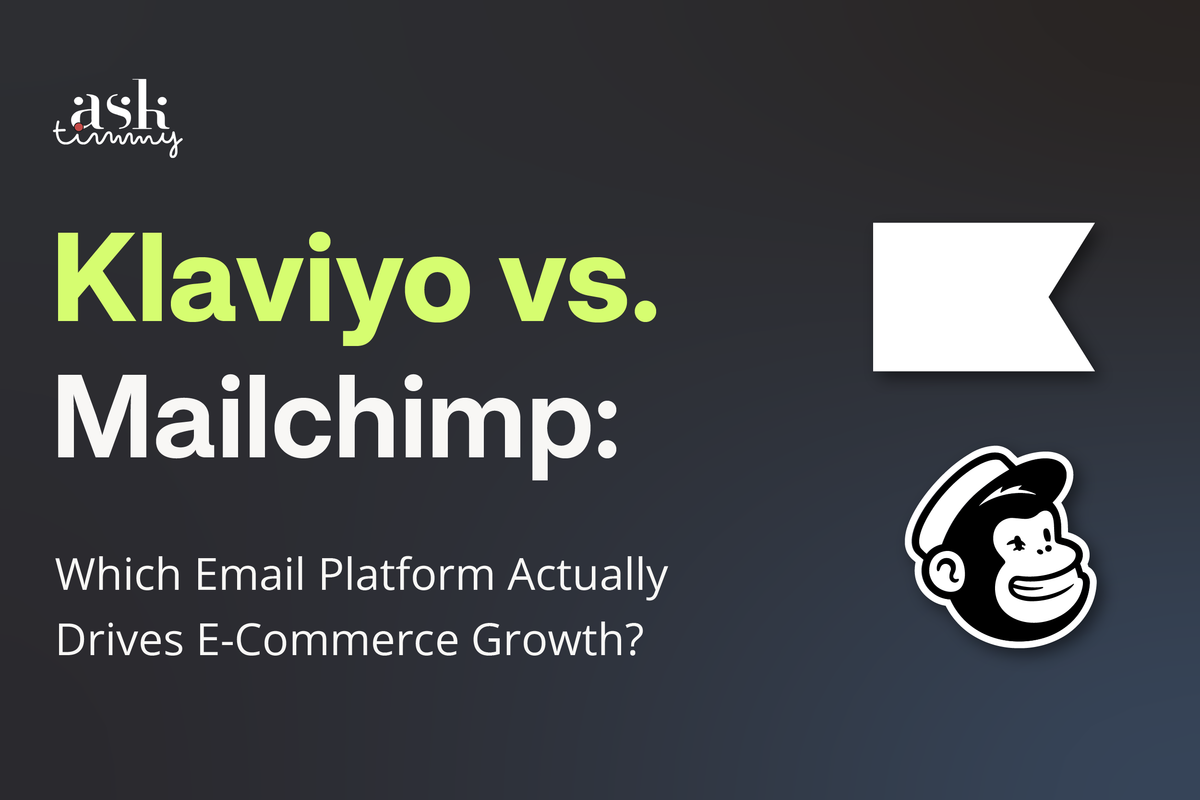
When you run an e-commerce brand, email isn’t just “marketing”, it’s one of the most profitable revenue channels you own. For most Shopify, WooCommerce, or BigCommerce stores, email contributes anywhere from 20% to 40% of revenue. This makes choosing the right platform critical.
When it comes to email marketing, Klaviyo and Mailchimp are two names that dominate the conversation. Both are powerful, both are well-known, and both are widely used. But they’re not interchangeable.
Klaviyo is a laser-focused platform for e-commerce, tracking every click, cart, and purchase to turn emails into revenue. Mailchimp is designed to get anyone, from bloggers to small businesses, up and running fast.
This article breaks down Klaviyo vs. Mailchimp specifically through the lens of e-commerce companies and marketers who serve them. We’ll look beyond surface features to the strategic differences that impact revenue.
Who These Tools Were Built For
This is where the divergence really starts.
- Klaviyo was built for e-commerce from the ground up. You can link it to one of 15 available e-commerce platforms like Shopify, BigCommerce, WooCommerce, and Magento. Every feature is designed to help you turn site visitors into first-time buyers and buyers into loyal repeat customers.
- Mailchimp was built as a general-purpose email platform. Bloggers, agencies, nonprofits, and small businesses widely use it. E-commerce tools exist, but they feel like bolt-ons, not the core of the product.
Takeaway: Both offer polished interfaces and similar layouts (left-hand navigation, tabs for campaigns, contacts, analytics). But their goals are different: Mailchimp aims to keep things effortless, while Klaviyo prioritizes advanced features that maximize revenue.
Ease of Use: Simplicity vs. Power
Ease of use depends on your objective, your purpose.
- Mailchimp prioritizes simplicity. Known for its friendly interface, drag-and-drop email builder, and polished templates. Beginners can send campaigns quickly without much training. It does not overwhelm you with options; it gives you what you want.
- Klaviyo has a steeper learning curve. The dashboard surfaces a lot of data, and workflows can look intimidating at first. However, that complexity exists for a reason: it enables you to run highly targeted, automated flows once you understand it.
For example, let’s look into the ‘tagging system’ of both platforms.
Mailchimp has an intuitive tagging system, making it easy for beginners. It imports contacts, tags them, and you’re done. Segmentation includes prebuilt groups like "Disengaged subscribers" or "High-value customers." You can also create custom segments using advanced targeting, but the defaults provide a good starting point.
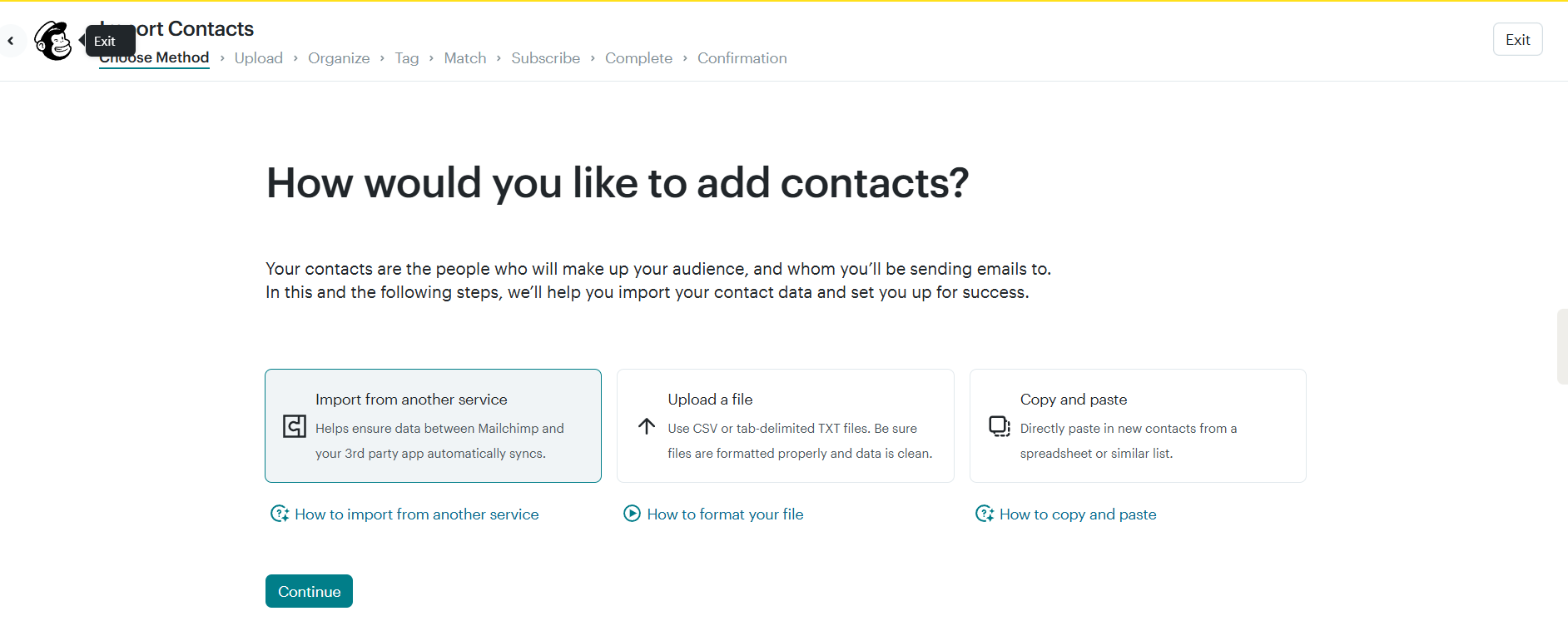
Klaviyo may seem complex at first. Adding contacts requires selecting lists before importing. Tagging exists but applies to lists and segments, not individual contacts. Once you understand it, the segmentation power is much greater.
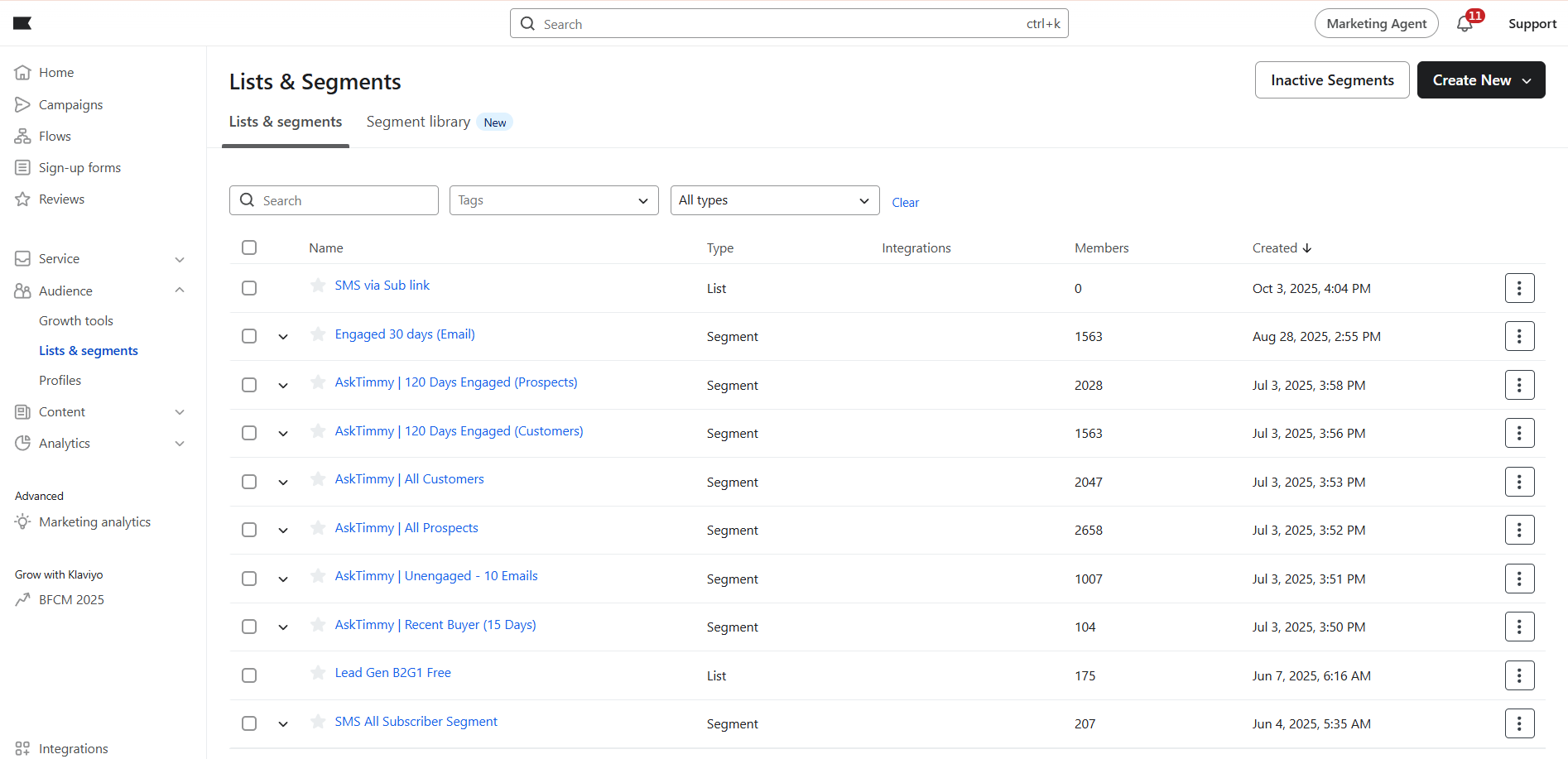
Takeaway: Mailchimp is faster to learn, but Klaviyo rewards the investment with precision. If you’re scaling, power matters more than simplicity.
Channels: All-in-One vs. Focused
- Mailchimp positions itself as an all-in-one marketing hub. You can run email, SMS, landing pages, ads, popups, surveys, and even social posts, all within the same platform. Mailchimp has also added an SMS marketing feature as a paid add-on—a powerful feature where you can combine email and text within automation flows.
- Klaviyo has traditionally stayed laser-focused on e-commerce email + SMS, integrating deeply with your store to deliver personalized experiences based on consumer behavior. Only recently has Klaviyo expanded into WhatsApp marketing—enabling brands to engage customers in real-time, interactive ways across the customer lifecycle.
Klaviyo WhatsApp Marketing
With Klaviyo, marketers can send branded WhatsApp campaigns powered by real-time data: promotions, order confirmations, delivery updates, and post-purchase follow-ups. Klaviyo brings WhatsApp into the omnichannel conversation alongside email, SMS, and mobile push for seamless, scalable engagement.
- It gives you a global reach of more than 3 billion monthly active users, dominating markets like the UK, France, Spain, and Italy.
- Gives you high engagement because it’s conversational, mobile-first, and privacy-compliant.
- In most regions, WhatsApp is the most trusted and effective channel, outperforming email, where inboxes are cluttered, and SMS, where customers find texts intrusive.
Automation: The Heart of E-Commerce Email
Automation is the heart of e-commerce email–abandoned cart, post-purchase, replenishment, win-backs, VIP rewards.
- Klaviyo: Automation is its strongest feature. You can trigger flows on almost any behavior: abandoned cart, product viewed, category browsed, repeat purchase reminders, and win-back campaigns. You can layer conditions like “placed order in the last 30 days but hasn’t purchased from [collection].” These flows run automatically and generate revenue.
The platform also includes Flows AI, which helps generate automation workflows based on natural language prompts. All you have to do is select the type of flow and describe it with details about the flow start, actions, delays, and logic. And viola! Your flow will be created.

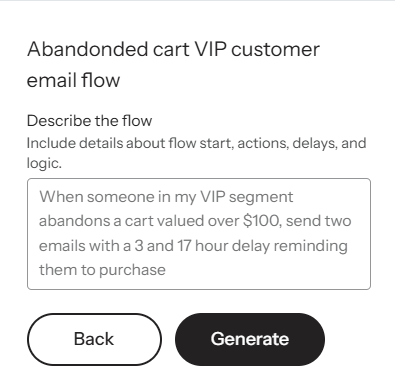
- Mailchimp: Offers 100+ prebuilt automations, but it’s limited to welcome series, birthday emails, and simple drip campaigns. It doesn’t go nearly as deep into purchase behaviors or browsing triggers, but variety makes automation accessible for smaller teams.
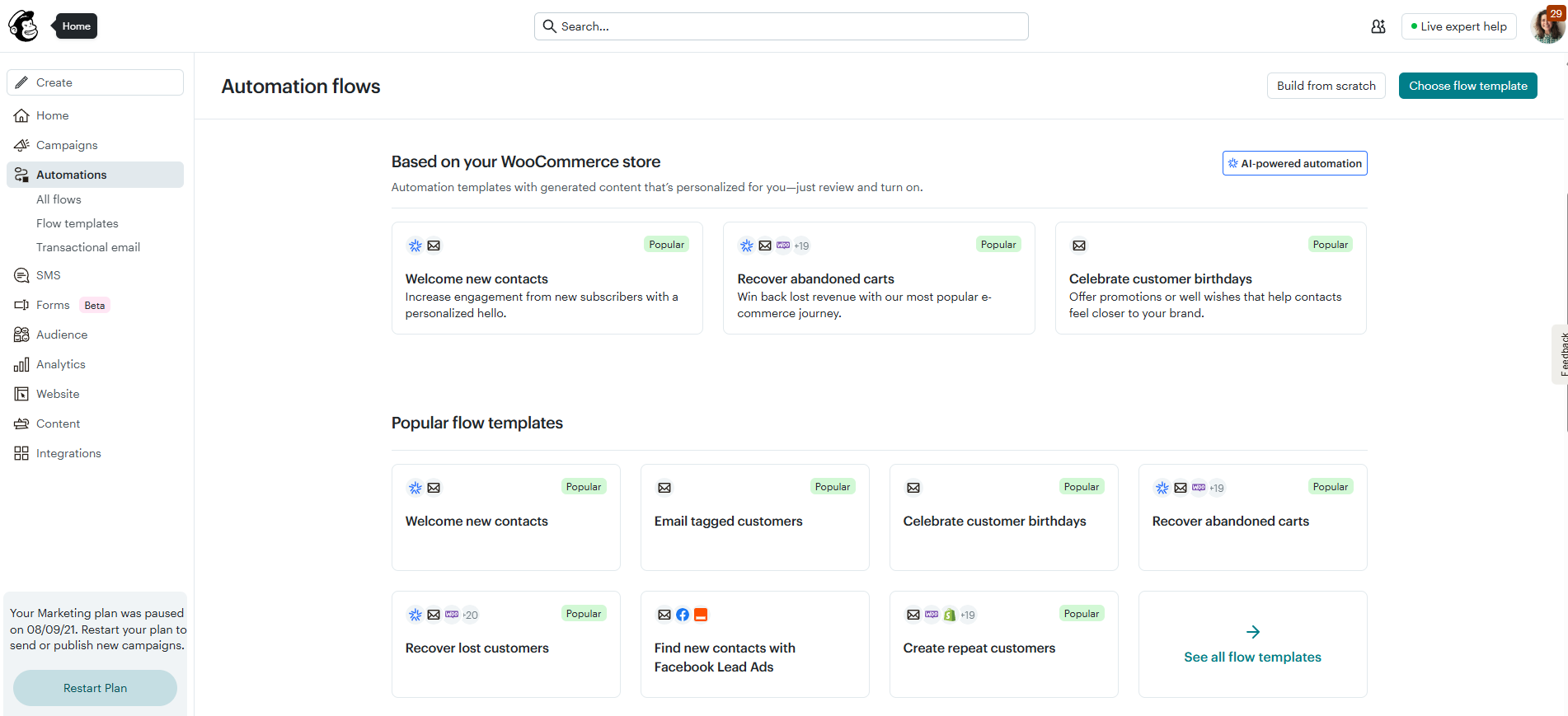
Segmentation & Personalization
This is where Klaviyo pulls ahead decisively.
- Klaviyo: Segmentation is hyper-granular. You can build segments by lifetime value, predicted churn risk, browsing history, frequency of purchase, or engagement level. Klaviyo also offers predictive analytics. For example, projecting when a customer is likely to reorder. That means you can trigger emails at exactly the right time.
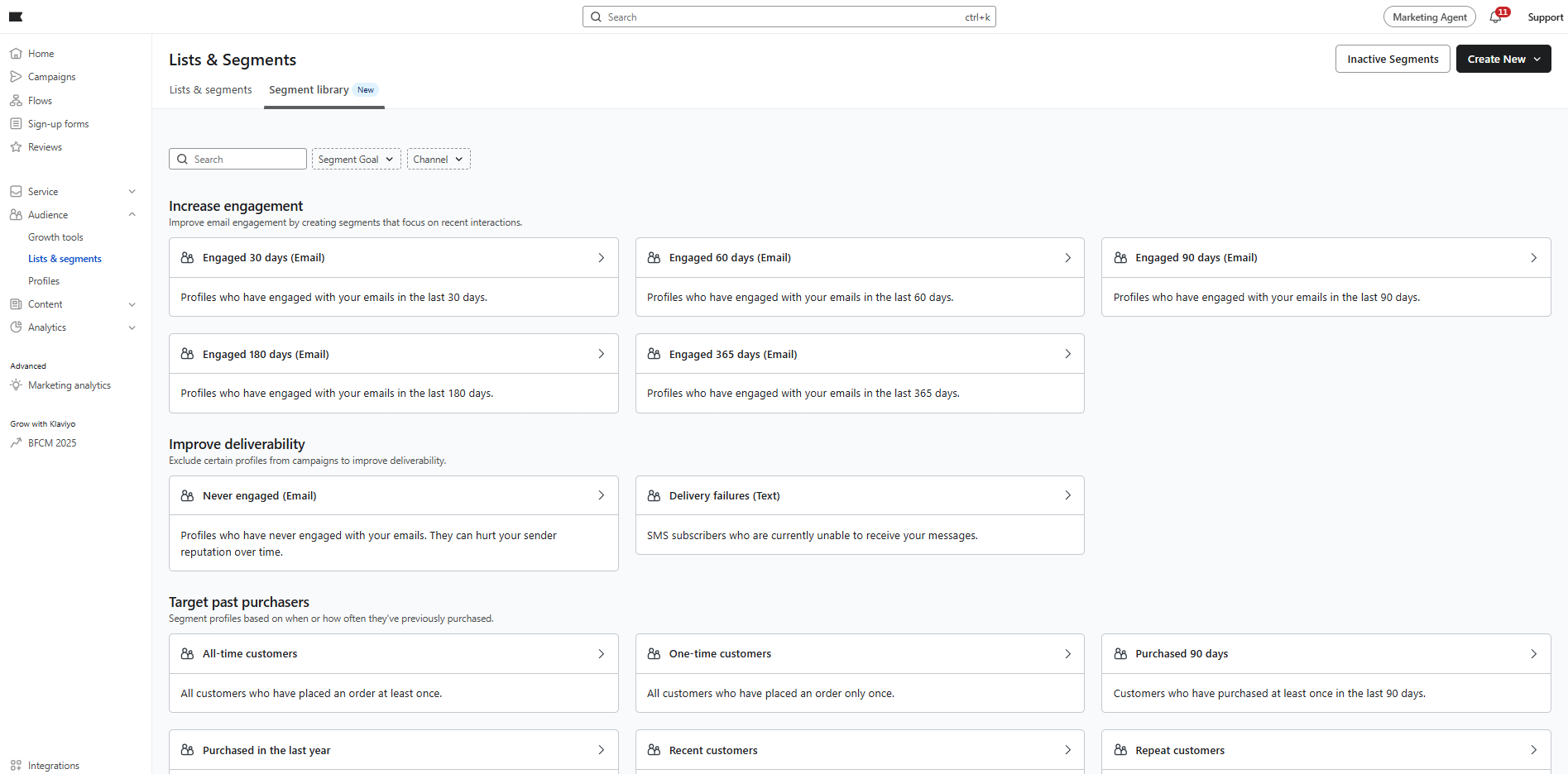
- Mailchimp: Prebuilt segments like “First-time customers” and “Disengaged subscribers” make it simple to target key groups. Great for smaller lists and marketers who want speed.

Takeaway: Mailchimp simplifies audience targeting. Klaviyo lets you dig into customer behavior in a way that directly impacts lifetime value. Mailchimp wins on accessibility. Klaviyo wins on business impact; its automations are built to recover revenue and boost repeat sales.
AI Creatives: Klaviyo vs. Mailchimp
AI is changing how fast you can move from blank page to polished campaign. Both Klaviyo and Mailchimp use AI creative tools, but they serve different types of marketers.
Klaviyo: AI Built for E-Commerce
Klaviyo’s K:AI is designed as an e-commerce-native creative partner. Instead of being an add-on, it’s built into every part of Klaviyo. From marketing to analytics, every service uses the same real-time data and intelligence.
K:AI includes two core AI agents:
- Marketing Agent can generate launch-ready campaigns, even turning a website URL into a complete marketing plan.
- Customer Agent provides round-the-clock customer support, answering product questions, recommending items, and sharing order updates.
Key features:
- Marketing service: K:AI Marketing Agent turns a website URL into a full marketing plan.
- Customer service: K:AI Customer Agent is available round the clock to cater to customers’ needs, product questions, recommend items, updates on orders, etc.
- Campaign copy generation: Generates subject lines, preview text, and body copy tied to past purchases or browsing behavior.
- Image remixing: Uses product photos you upload and creates on-brand visual variations (colors, styles, formats).
- Personalization at scale: Can tweak tone and offers for segments like VIPs vs. new customers.
- Flow integration: Suggestions are embedded in automated flows, like cart abandonment or post-purchase.
Klaviyo’s strength lies in its ability to identify who you’re targeting and what they’ve purchased. That makes its creative outputs sharper for revenue-focused campaigns.
Mailchimp: AI for Speed and Simplicity
Mailchimp’s Creative Assistant is designed to get a campaign idea to send fast. Unlike Klaviyo, it doesn’t live inside ecommerce data by default. Instead, it focuses on making it easy for small businesses to launch campaigns with polished creative, even if they don’t have a designer or copywriter.
Key features:
- Automates personalized campaigns at scale
- Brand kit integration: Pulls your fonts, colors, and logos into layouts automatically.
- Copy generation: Suggests subject lines, headers, and body copy from short prompts.
- Design suggestions: Recommends layouts, images, and colors that match your brand.
- Multi-channel output: Generates copy not just for email but also for social posts and ads.
Mailchimp’s outputs are broader and less personalized, but they’re fast, simple, and consistent across channels.
Analytics & Reporting
Analytics is where the difference between Mailchimp and Klaviyo shows up most clearly.
Mailchimp: Campaign-Centric Insights
Mailchimp’s reporting is anchored in campaign-level engagement metrics:
- Opens, clicks, unsubscribes, and bounce rates form the foundation.
- Click maps and audience growth reports give a visual sense of engagement.
- Revenue reporting exists, but it requires e-commerce integrations and is most fully unlocked on higher-tier plans.
- Predictive metrics are limited — you’ll see how a campaign performed, but you won’t get deep insight into future customer behavior.
In practice, this works well for newsletters, content-driven brands, or small businesses that need quick reads on “what performed” without diving into lifetime customer value.
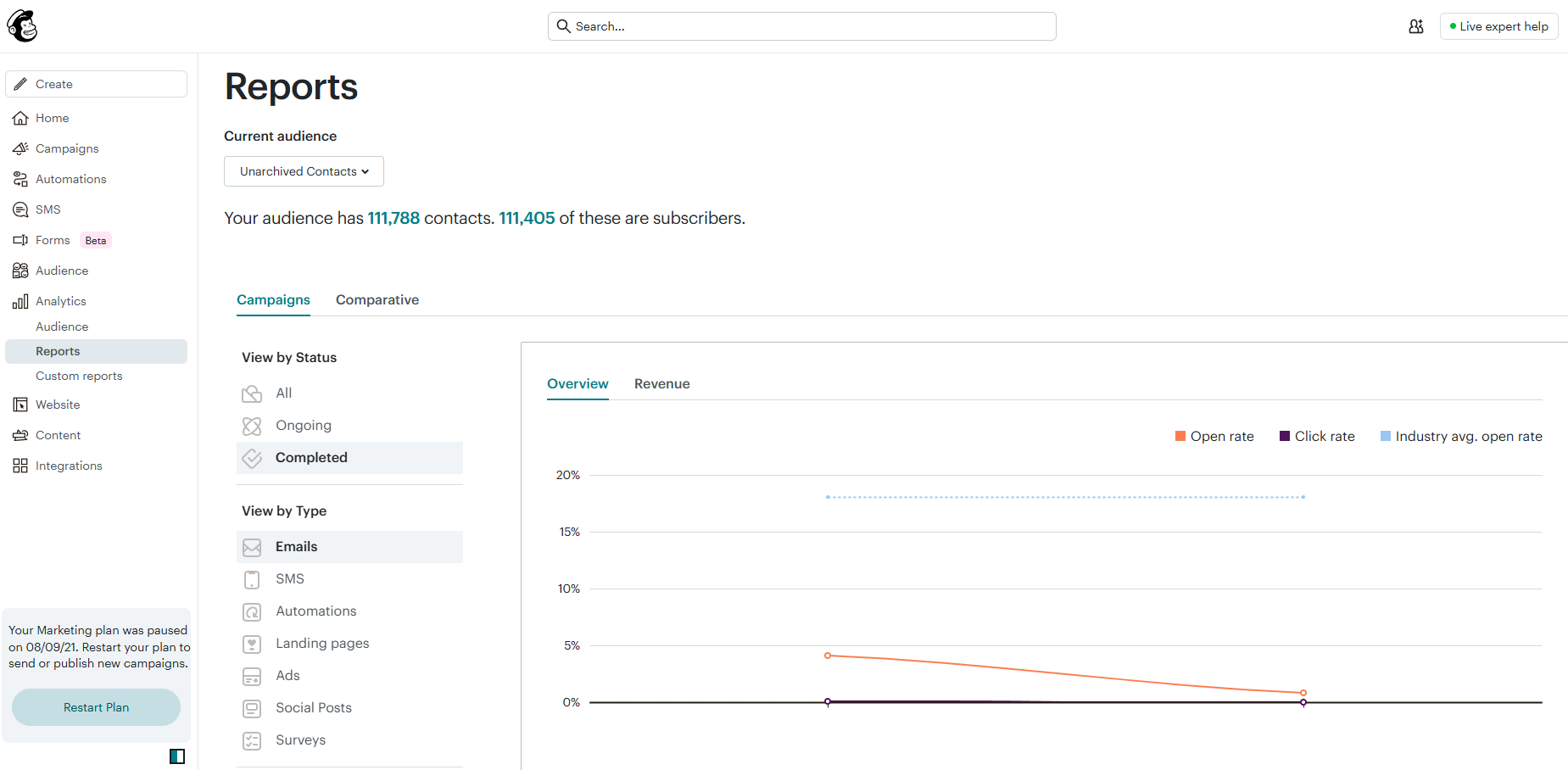
Klaviyo: Revenue-First Intelligence
Klaviyo’s reporting flips the script: every email, SMS, or flow is tied directly to revenue generated.
- Revenue attribution: See exactly how much revenue each campaign or automation drives, down to per-recipient ROI.
- Predictive analytics: Built-in models estimate customer lifetime value (LTV), churn risk, and next order date, so you can tailor campaigns before customers disengage.
- Benchmarking: Compare your brand’s performance against similar businesses (by industry and size) for context.
- Flow-level performance: Track not just campaigns but automations (e.g., cart abandonment, win-back) to see which flows produce the highest ROI.
This makes Klaviyo especially valuable for e-commerce brands.
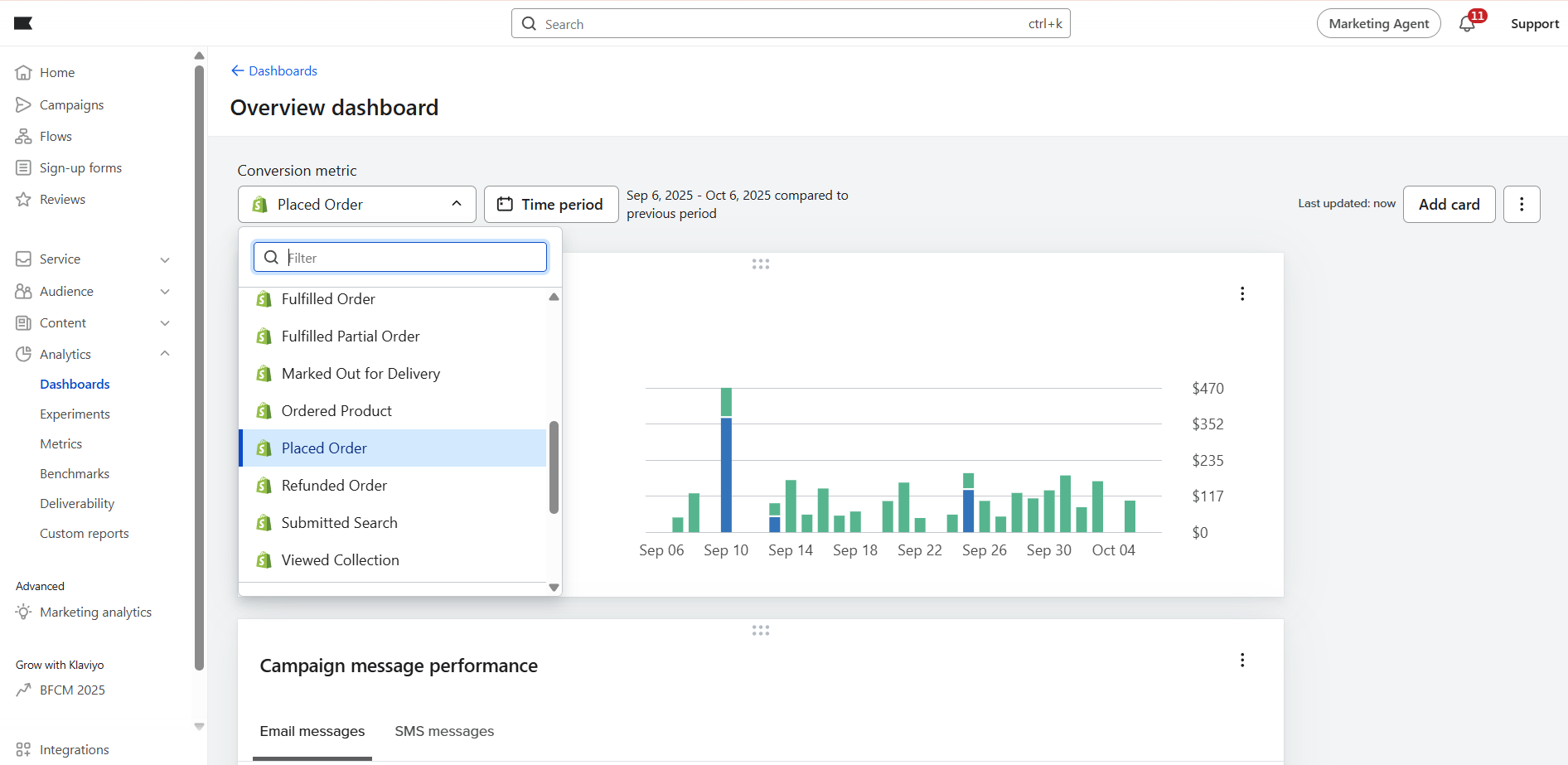
Klaviyo Pricing vs Mailchimp
Both platforms offer free plans, but their pricing models cater to different customer bases.
Klaviyo: All Features, But Premium Pricing
- Free plan: Up to 250 contacts and 500 email sends, with full access to flows, automations, and A/B testing.
- Scaling cost: Pricing increases with list size.
- ~$350/month for 15,000 contacts
- ~$500/month for 30,000 contacts
- SMS pricing is separate and based on usage.
The advantage is that even at the free level, you get enterprise-grade functionality, features that other platforms reserve for high-paying tiers. The downside: costs climb steeply as your list scales.
Mailchimp: Low Barrier, Wide Reach
- Free plan: Up to 500 contacts and 1,000 monthly email sends. Good for micro-businesses.
- Essentials plan: Starts at $13/month for 500 contacts, scaling modestly as you grow.
- Standard and Premium tiers: Add features like send-time optimization, advanced segmentation, and comparative reports.
Mailchimp’s gradual pricing makes it attractive for startups and small businesses. The tradeoff: to unlock richer analytics or ecommerce reporting, you often need to move into the higher tiers.
Feature Comparison Table: Klaviyo vs. Mailchimp
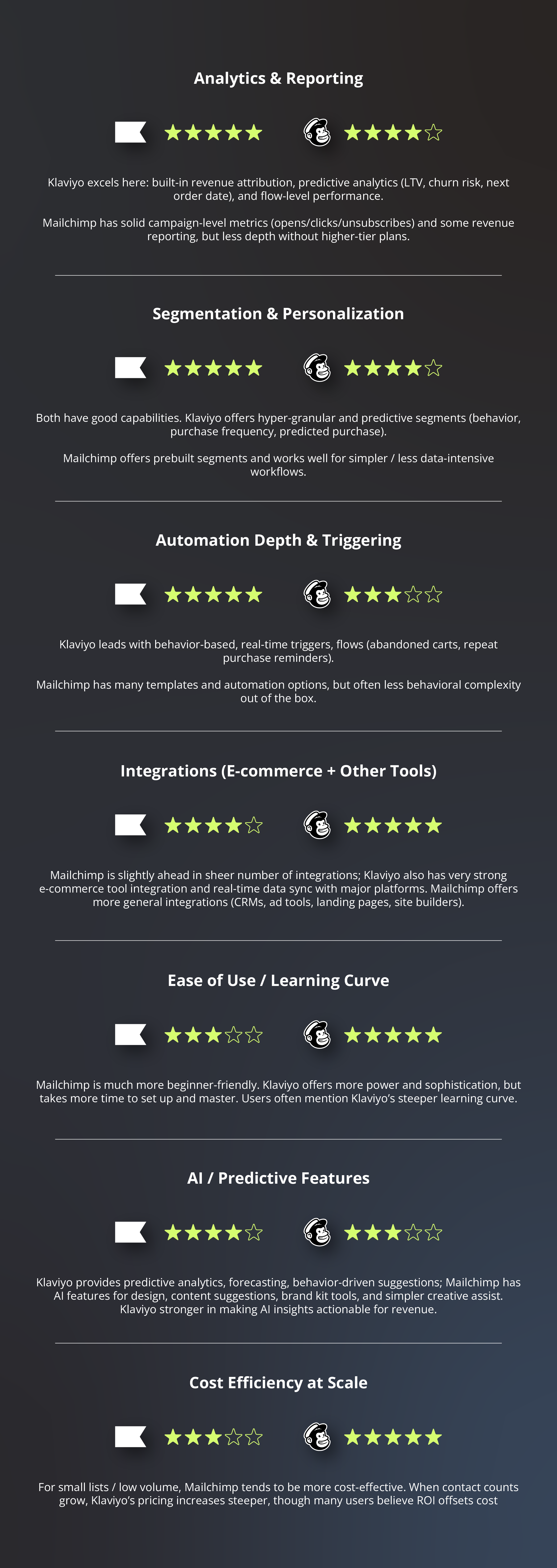
Klaviyo vs. Mailchimp: Which Email Platform Actually Drives E-Commerce Growth?
With email marketing responsible for 20% to 40% of your revenue, it isn’t just another marketing channel.
So, Klaviyo vs. Mailchimp: which is best for you?
Choose Mailchimp if:
- You’re a small business, creator, or nonprofit that values ease of use and affordability.
- You need an all-in-one tool for email, social posts, landing pages, and simple automations.
- Engagement metrics (opens, clicks, and unsubscribes) are sufficient to measure your campaign's effectiveness.
Bottom line: Mailchimp is ideal for beginners or teams that require campaigns to go live quickly without a steep learning curve, and its AI automation features are surprisingly advanced.
Choose Klaviyo if:
- You run an e-commerce store on Shopify, WooCommerce, BigCommerce, etc.
- You care about revenue attribution, predictive analytics, and flows tied to customer behavior.
- Your goal is to drive engagement, boost sales, and increase ROI, and you’re ready to invest time in learning.
Bottom line: Best for e-commerce brands ready to scale revenue through advanced automation, predictive analytics, and data-driven personalization.